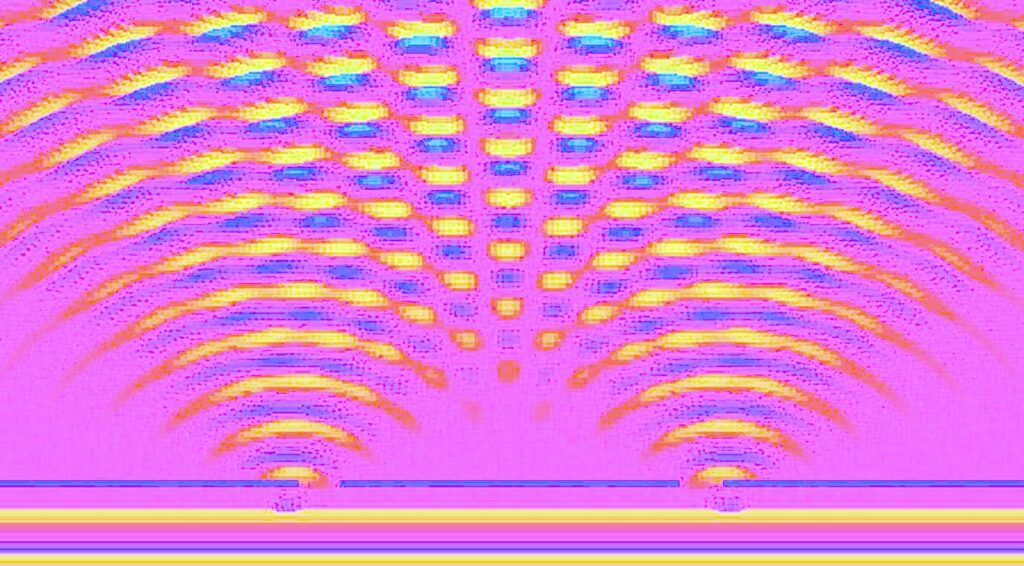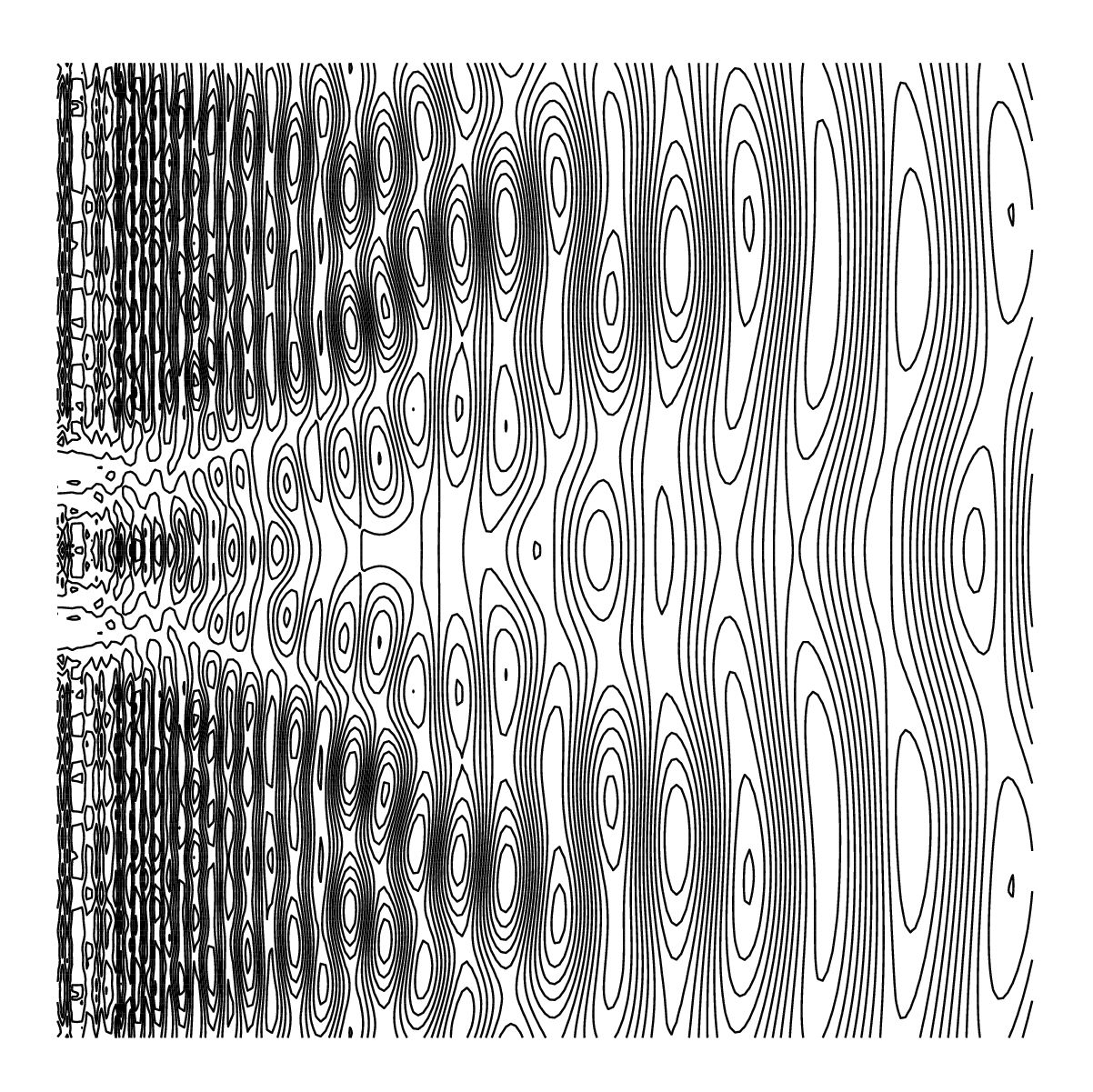
(5.<=) Abbiamo a questo punto tutti gli elementi per affrontare alcuni aspetti più cruciali riguardanti la materia, la quale si presenta come una combinazione di particelle cariche e munite di massa, immerse in un mare agitato di quella che potremmo chiamare pseudo-materia. Quest’ultima non funge solo da sottofondo, ma contribuisce in modo unico nel caratterizzare la struttura delle molecole. Il riempimento elettromagnetico non è conseguenza del movimento degli elettroni (che nel nostro caso hanno poca libertà). Esso era fisicamente presente ben prima che la materia fosse formata e viene modellato da essa attraverso l’azione preponderante dei nuclei atomici. Strutture elettromagnetiche, aventi una topologia prevalentemente a forma di anello, sono quindi intrappolate tra nuclei ed elettroni. Si evolvono in maniera periodica esibendo frequenze che sono inversamente proporzionali alla loro grandezza. Se opportunamente sollecitate possono essere espulse sotto forma di fotoni.
(5.<=) At this point we have all the elements to address some of the most crucial aspects concerning matter, which presents itself as a combination of charged massive particles, immersed in a troubled sea of what we could call pseudo-matter. The latter not only acts as a background but contributes in a unique way in characterizing the structure of the molecules. The electromagnetic filling is not a consequence of the movement of the electrons (which in our case have little freedom). It was physically present long before matter was formed and is shaped by it through the predominant action of atomic nuclei. Electromagnetic structures, mainly displaying a ring-shaped topology, are therefore trapped between nuclei and electrons. They evolve periodically exhibiting frequencies that are inversely proportional to their size. If suitably stressed, they can be expelled in the form of photons.
Come è stato asserito in precedenza, tutta questa energia in movimento porta ad una deformazione dello spazio-tempo in base alla teoria della relatività generale, con la conseguente generazione di quella che è stata chiamata pseudo-massa. Affinché tali strutture dinamiche rimangano confinate è lecito supporre che l’informazione stia seguendo geodetiche la cui curvatura è molto accentuata, tanto da rimanere all’interno del reticolo atomico. Non ci sono masse così grandi da produrre effetti di tale entità, per cui la pseudo-massa deve essere conseguenza delle equazioni di Einstein dove le costanti in gioco sono molto più grandi di quelle che vengono in genere attribuite ai fenomeni di tipo astronomico o cosmologico. A tal proposito citiamo il report menzionato alla fine di questa pagina. Questo aspetto conferisce ancora più importanza alla pseudo-materia, la quale in fin dei conti partecipa all’interno della materia con una percentuale enorme del volume totale. Difatti, se si potessero raggruppare e comprimere tutti gli elementi massivi di un pezzo di materia, essi occuperebbero un volume infinitesimo rispetto a quello originale. Particelle atomiche e pseudo-materia diventano quindi entità inseparabili: ciascuna ha bisogno dell’altra al fine di costruire la materia vera e propria. Anche le varie proprietà attribuibili alla materia (chimiche, meccaniche, elettriche, magnetiche, ecc.) devono tenere conto della presenza della pseudo-materia. Per tale motivo, nell’ambito della meccanica quantistica, dove ogni cosa viene ricondotta alla presenza di particelle, si introducono le quasi-particelle, come ad esempio i fononi, gli eccitoni, i polaroni, i rotoni, ecc. Per quanto ci riguarda, queste manifestazioni sono tutte figlie dell’elettromagnetismo e di come certe sue strutture si evolvono al pari di un fluido all’interno della materia.
As previously stated, all this energy in motion leads to a space-time warping according to the theory of general relativity, resulting in the generation of what has been called pseudo-mass. In order for these dynamic structures to remain confined, it is legitimate to assume that the information is following geodesics whose curvature is very accentuated, so as to remain within the atomic lattice. There are no masses so large as to produce effects of this magnitude, so the pseudo-mass must be a consequence of Einstein’s equations where the constants involved are much larger than those generally attributed to astronomical or cosmological phenomena. In this regard we cite the report mentioned at the end of this page. This aspect gives even more importance to pseudo-matter, which ultimately contributes within matter to a huge percentage of the total volume. In fact, if all the massive elements of a piece of matter could be assembled and compressed, they would occupy an infinitesimal volume compared to the original one. Thus, atomic particles and pseudo-matter become inseparable entities: each needs the other in order to build true matter. The various properties accountable to matter (chemical, mechanical, electrical, magnetic, etc.) must also take into account the presence of pseudo-matter. For this reason, in the field of quantum mechanics, where everything is traced back to the presence of particles, quasi-particles are introduced, such as phonons, excitons, polarons, rotons, etc. As far as we are concerned, these manifestations are all consequences of electromagnetism, and the way certain electromagnetic structures evolve like a fluid inside matter.
Sebbene tutto quanto sia stato finora affermato richieda ancora una dimostrazione formale, risulta chiaro che il nostro approccio, una volta validato, è in grado di unificare e ricondurre ad origini comuni molti fenomeni che appaiono al momento slegati o che non abbiano ancora trovato risposte soddisfacenti. Rimanendo in ambito euristico, la superconduttività a basse temperature verrebbe spiegata attraverso una rarefazione dei legami energetici fra le molecole (quindi meno strutture elettrodinamiche in evoluzione) che permetterebbe un passaggio diretto dei fotoni attraverso il reticolo, portando in questo modo informazioni a velocità comparabili a quella della luce. Anche questa volta non c’è movimento di elettroni, ma ciò accade anche in meccanica quantistica dove sono le quasi-particelle a spostarsi.
Although all that has been stated so far still requires a formal demonstration, it is clear that our approach, once validated, would be able to unify and lead back to common origins many phenomena that currently appear unrelated or have not yet found satisfactory answers. Remaining in the heuristic context, superconductivity at low temperatures would be explained through a rarefaction of the bonds between molecules (therefore fewer electrodynamic structures in evolution) which would allow a direct passage of the photons through the lattice, thus carrying information at speeds comparable to that of light. Even now there is no movement of electrons, however this also happens in quantum mechanics where it is the turn of the quasi-particles to move.
Tuttavia, la più importante conseguenza di questo modo di ragionare ci porta a spiegare come avvenga il fenomeno della diffrazione, dove i raggi di luce (sotto forma di singoli fotoni che viaggiano in maniera coerente) vengono deviati, cambiando la loro traiettoria in spazi molto stretti. La nostra interpretazione è che essi interagiscano con gli avvolgimenti dinamici della pseudo-materia, così come un getto d’acqua farebbe tra i flutti di un ruscello. Inevitabilmente, siamo arrivati a discutere del famoso esperimento della doppia fenditura. Qui la nostra visione si discosta notevolmente da quella della meccanica quantistica, riportando i ragionamenti più a livello del buonsenso. La frange di interferenza non nascono dall’interazione tra le particelle (elettroni, fotoni o altro) lanciate attraverso le fenditure. Esse esistono ancor prima che l’esperimento venga effettuato. Appartengono al supporto non appena i due buchi vengono aperti. Fanno parte della complicata conformazione elettromagnetica che compone e circonda tale supporto. Nel loro passaggio, le particelle mettono solo in luce una situazione già preesistente. Queste considerazioni ci fanno comprendere come sia complicata la materia che ci circonda, in quanto nasconde alla vista diretta molti dettagli che possono essere individuati solo tramite appropriati esperimenti. Al contempo ci viene insegnato che il comportamento non potrebbe essere diverso, dal momento in cui cerchiamo di unificare l’origine delle cose in un’unica teoria.
Nevertheless, the most important consequence of this way of reasoning leads us to explain how the phenomenon of diffraction occurs, where the light rays (in the form of single photons traveling in a coherent manner) are deflected by changing their trajectory in very narrow spaces. Our interpretation is that they interact with the pseudo-matter dynamic windings, just as a jet of water would do among the waves of a stream. Inevitably, we came to discuss the famous double slit experiment. Here our view deviates considerably from that of quantum mechanics, bringing the reasoning more to the level of common sense. The interference fringes do not arise from the interaction between the particles (electrons, photons or other) thrown through the slits. They exist even before the experiment is performed. They belong to the support as soon as the two holes are opened. They are part of the complicated electromagnetic conformation that forms and surrounds such a support. In their passage, the particles only highlight an already existing situation. These considerations make us understand how complicated the matter that surrounds us is, as it hides many details from direct view that can only be detected through appropriate experiments. At the same time, we are taught that the behavior could not be different, whenever we try to unify the origin of things in a single theory.
 | Rozza simulazione statica di quella che potrebbe essere l’energia del sottofondo elettromagnetico, distribuita all’esterno di un supporto di materia (a sinistra) avente due fenditure ravvicinate. I nuclei degli atomi deformano in maniera dinamica l’ambiente circostante, creando caratteristici avvallamenti. Una particella passante attraverso una fenditura subisce una variazione del cammino, la quale dipende dalla posizione iniziale e dallo stato in cui si viene a trovare il sottofondo durante il viaggio. L’interferenza non avviene dunque fra particelle, ma fra ogni singola particella e il sottofondo. | Rough static simulation of what might be the background electromagnetic energy distributed outside a support of matter (to the left), presenting two closely spaced slits. The nuclei of atoms dynamically deform the surrounding environment, creating characteristic bumps and dips. A particle passing through a slit undergoes a path variation, which depends on the initial position and on the state in which the background is found during the journey. The interference therefore does not occur between particles, but between each individual particle and the deformed background. |
————————————————————————-
- D. Funaro, Spacetime Deformations of Electromagnetic Nature are Far from Negligible, Preprint (2023), This essay received an Honorable Mention in the 2023 Essay Competition of the Gravity Research Foundation, hal.science/hal-04095803v1.